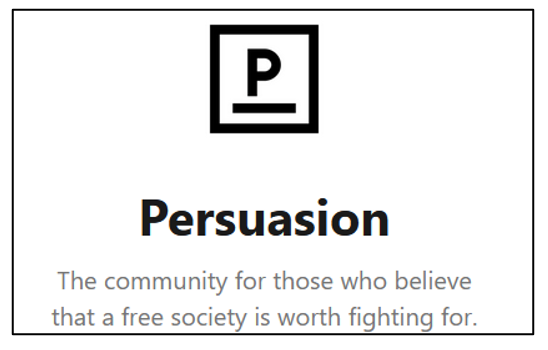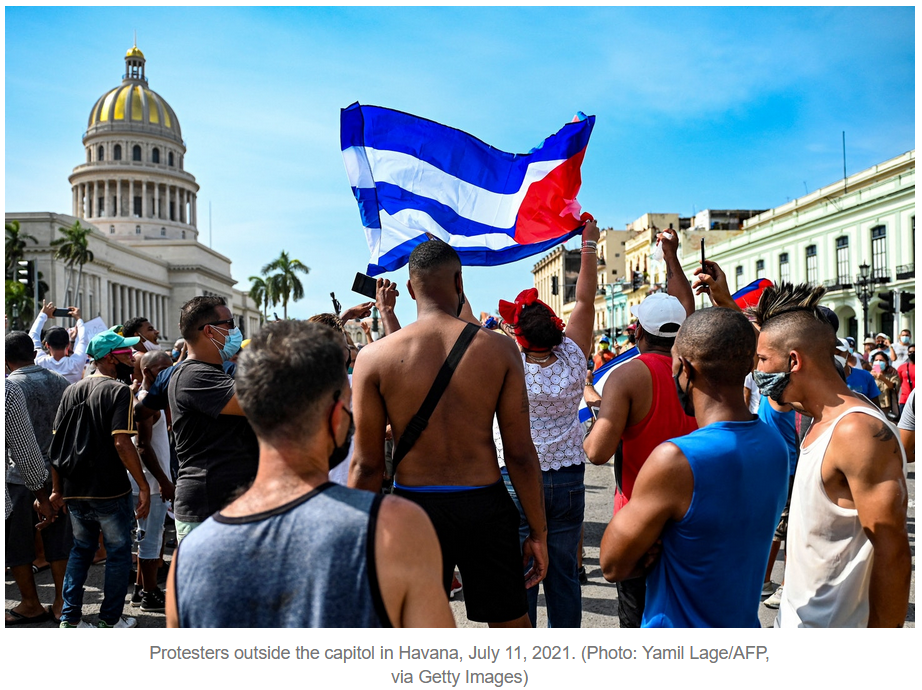
By James Bloodworth, July 14, 2021
Cubans have been living under dictatorship in some form since 1952. They spent most of the 1950s living under the corrupt rule of Fulgencio Batista, an army colonel who overthrew the last elected Cuban leader, Carlos Prío Socarrás, in a coup d’état. Batista was himself overthrown seven years later, on Jan. 1, 1959, by Fidel Castro’s guerrilla army.
Today Cubans live under the political system imposed by Castro 62 years ago, a tropical version of the state socialist model that prevailed in Eastern Europe until 1989. Roadside billboards still exhort Cubans to build socialism, but the economy has been all but bankrupt since the Soviet Union cut off aid shipments in the early 1990s.
I spent over a year in Cuba in my early twenties. During my stay on the island, I got to see beyond the romantic iconography of “Fidel” and “Che” (for the Argentine revolutionary Ernesto “Che” Guevara) that are so often synonymous with Cuba. Some days it would be impossible to find soap or toilet paper in the state-run shops. I used to sneak into a hotel on the Malecón, Havana’s iconic seawall, to pilfer breakfast and take it home to the Cubans I was staying with. The monthly Libreta de Abastecimiento, or supplies booklet that Cubans were given by the government, hardly covered a week, let alone a month. Most of my young Cuban friends were plotting their escape from the island, usually via marriage with some love-struck European or Canadian tourist.
When I returned to England, I noticed two things. One, invariably, was the sheer level of material comfort I could enjoy. No more blackouts or whiling away hours every day waiting in lines. No more toilets without a functioning flush. No more waiting outside the police station for friends who had committed the “crime” of fraternizing with tourists.
I was also struck by the stubbornness with which many Western friends would cling to their illusions about Cuba, even though few who actually lived on the island seemed to believe in socialism anymore. While my Cuban friends were seeking a way out of Castro’s dungeon, left-wing companions who lived thousands of miles away behaved as if Cuba remained a tropical paradise.
For those willing to admit that things might not be perfect on the island, the poverty and lack of democracy were usually blamed on Yankee imperialism. The same friends who would raise hell when they heard about any injustice in the West would “suddenly become wise historiosophists or cool rationalists when told about worse horrors of the new alternative society,” as the Polish philosopher and former communist Leszek Kołakowski wrote during the Cold War to the English historian EP Thompson. Thompson had accused Kołakowski of apostasy for abandoning the revisionist communism of his youth.
To be sure, occasionally some better-known admirer of the dictatorship was honest enough to admit that they themselves could never live under the Cuban system. The late Colombian writer Gabriel García Márquez once told The New York Times that he would “miss too many things” were he to actually live in Cuba. “I couldn’t live with the lack of information. I am a voracious reader of newspapers and magazines from around the world,” García Márquez said. For the Cubans, however, these apparently were acceptable privations.
The Cuban government and its supporters have a reflexive response to criticism, which is to blame the United States for the situation on the island. Much of the left has responded to the wave of spontaneous protest currently sweeping Cuba by echoing the line from Havana. Cuban protesters have been filmed chanting “libertad”(freedom) and “abajo la dictadura” (down with the dictatorship). Yet according to the Democratic Socialists of America, the largest socialist organization in the United States, what Cubans are really protesting is the “blockade,” which is actually a trade embargo: Cuba is free to trade with anyone in the world except the United States. “DSA stands with the Cuban people and their Revolution in this moment of unrest. End the blockade,” the group’s International Committee tweeted on July 11.
The explicitly Leninist reasoning of this logic—that the Cuban people are represented by the communist dictatorship whether they like it or not—has its roots partly in a crude strain of anti-Americanism that is popular among young, politically active, and left-leaning Americans.
But it also makes a virtue out of self-deception and forgetting. It is now over three decades since the Berlin Wall came down and the Soviet archives were prized open, revealing the grisly manner in which Stalinist political systems impoverished and oppressed those unfortunate enough to live under their rule. And yet political convenience—along with tropical sunshine and the romantic iconography of bearded men in olive-green fatigues—is the midwife of historical amnesia. In The God that Failed, an autobiographical essay on his disillusionment and abandonment of Marxism published in 1949, the novelist Arthur Koestler likened communist fellow travelers to Peeping Toms, peering through a hole in the wall at “history” while not having to experience it themselves. In Koestler’s time, one might (just about) have pleaded ignorance as to what was taking place under “actually existing socialism.” No such moral leeway can be granted to their contemporary equivalents.
It is true that the U.S. has long exerted a malign influence over Cuba. It has invaded the island and tried to murder its leaders. Furthermore, it has attempted to subvert the Cuban economy for decades through its trade embargo.
The U.S. has pursued this course not to promote democracy in Cuba. Rather, it decided many decades ago that it was going to squeeze Cuba because the Cubans nationalized American businesses on the island. Before the revolution, the U.S. had more money invested in Cuba than in any other Latin American country except Venezuela. To make the point in a slightly different way, the U.S. maintains cordial relations with countries that have worse human rights records than Cuba, but those countries have not had the temerity to interfere with American business interests.
Yet the situation in Cuba—the poverty, the repression, the top-down Leninist political structure—is as much a product of forces within Cuba as a consequence of U.S. policy. Havana’s Communist Party veterans have no intention of opening Cuba up to the world; that would risk diluting the power they wield over their subjects. Nor are things as simple as saying that the United States “pushed Cuba into the arms of the Soviet Union” during the 1960s, as the popular liberal explanation goes for Cuba’s descent into tyranny. It is more accurate to say that the United States’ belligerence towards Cuba strengthened the hand of those in Castro’s revolutionary movement who already considered the USSR their ideological lodestone. As Che Guevara told the French weekly L’Express in 1963: “Our commitment to the [Soviet model] was half the fruit of constraint and half the result of choice.”
The Soviet model of socialism still exists in Cuba.Elections are a sham. There are no independent trade unions. There is one official newspaper, Granma, and the Communist Party decides what gets published. Speak out against the government and you will lose your job and possibly end up in jail. The exiled Cuban writer Reinaldo Arenas, who was driven out of his homeland in 1980 for his writing and homosexuality, put it well in his autobiography: “The difference between the communist and capitalist systems is that, although both give you a kick in the ass, in the communist system you have to applaud, while in the capitalist system you can scream.”
Committees for the Defense of the Revolution exist on every block in every town and city in Cuba to, as Fidel Castro once put it, “know who everyone is, what each person who lives on the block does, what relations he had with the tyranny, to what he is dedicated, whom he meets, and what activities he follows.”
But Cuba’s Soviet-style, state-run economic model does not work even if the U.S. embargo makes the situation worse. Day-to-day macroeconomic policy consists of centralized control of systematically induced shortages. It is no coincidence that Cuba is plagued by the same economic distortions that once beset Eastern Europe’s vanished communist dictatorships. Central planning always turns out like this, which is why countries such as China have long abandoned it.
The wave of protests this past week show that Cuba may soon be approaching its own 1989 moment. Thousands of people marched in cities and towns across the island to protest the conditions imposed on them by the dictatorship. Foreign news organizations have noted the protests over vaccines and blackouts, but in many of the videos that have emerged the Cubans themselves could be heard demanding “freedom.”
For those of us who closely follow events in Cuba, this has been a remarkable and unprecedented development. As Stephen Gibbs writes for the Times of London: “Millions of Cubans who have never seen any significant protest in their lifetimes saw one unrolling live before them. They now know what is possible.”
I have seen the slogan “Hands Off Cuba” being used by sections of the Western left in response to this week’s protests. But if such slogans are to mean anything, they should be directed at the decrepit dictatorship, which right now is the biggest fetter to Cuba’s future.
Cuba is a nation of more than 11 million people who have waited 70 years for the right to interfere in their country’s internal affairs. It is a diverse and complex society; it is more than Fidel and Che. The left should stand with the protesters, even if it means letting go of comforting romantic illusions.
James Bloodworth is a journalist and the author of Hired: Six Months Undercover in Low-Wage Britain.


